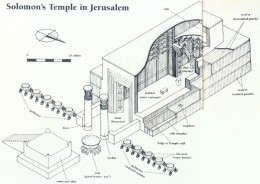What is a “mezuzah” in the Bible?
King Solomon’s Temple was resplendent. Described in 1 Kings 6–7, the temple was divided into three parts: the forecourt (ulam), the outer sanctum (heikhal) and the inner shrine (devir), also known as the Holy of Holies. Built of stone and roofed with wooden beams, Solomon’s Temple was intricately ornamented. Its interior walls and floors were lined with wooden boards and covered in gold. It took seven years to complete the temple and its furnishings.
Despite the Biblical description and archaeological parallels, there are still some mysteries about Solomon’s Temple. For example, 1 Kings 6:31 describes the doors between the outer sanctum and the inner shrine of Solomon’s Temple as having five mezuzot (the plural form of mezuzah).
What is a mezuzah? In the Bible, mezuzah is normally translated as “doorpost.” However, in the context of Solomon’s Temple, doors with five doorposts do not make sense.
Madeleine Mumcuoglu and Yosef Garfinkel explore this enigma in “The Puzzling Doorways of Solomon’s Temple” in the July/August 2015 issue of BAR. They contend that a recent discovery from Khirbet Qeiyafa may hold the answer to unlocking the meaning of a mezuzah in the Bible regarding Solomon’s Temple.




This is an example of a modern mezuzah secured to a doorframe. However, this is not what is meant by a mezuzah in the Bible—and not how we should envision the doorways of Solomon’s Temple. Photo: “Mezuzah at Chesed-El Synagogue, Singapore – 20100815,” by SMUConLaw is licensed under CC-BY-SA-3.0.


This building model from Khirbet Qeiyafa depicts an elaborate doorframe surrounding an opening. With three—or maybe four—interlocking frames, the recessed doorframe sets apart the inner room as sacred space. This model may unlock the meaning of a mezuzah in the Bible regarding the description of Solomon’s Temple. Photo: G. Laron/Courtesy of the Khirbet Qeiyafa Expedition.
Located 20 miles from Jerusalem, Khirbet Qeiyafa was occupied in the 11th–10th centuries B.C.E. It is noteworthy as being a fortified site in Judah from the time of King David.
Madeleine Mumcuoglu and Yosef Garfinkel present a building model from Khirbet Qeiyafa that depicts a doorframe with three—or maybe four—interlocking doorframes surrounding an opening. They suggest that these interlocking frames are what is meant by mezuzot in the description of Solomon’s Temple. According to their interpretation, then, the doors to the inner shrine (devir) of Solomon’s Temple did not have five doorposts—but rather five recessed doorframes.
Temples with recessed doorways have been uncovered throughout the ancient Near East, and Madeleine Mumcuoglu and Yosef Garfinkel further note that recessed doorframes set apart inner rooms and spaces as being sacred. In the case of Solomon’s Temple, the more recessed the doorframes, the holier the space:
There is a gradual increase in the number of recessed doorframes from the entrance to the forecourt (three) to the outer sanctum (four) and finally to the entrance from the outer sanctum to the devir (five). It is as if the devir had the highest number of mezuzot because it was the most sacred part of the Temple.
For a full description of the doorways of Solomon’s Temple—and parallels throughout the ancient Near East—read the article “The Puzzling Doorways of Solomon’s Temple” by Madeleine Mumcuoglu and Yosef Garfinkel in the July/August 2015 issue of BAR.
——————BAS Library Members: Read the full article “The Puzzling Doorways of Solomon’s Temple” by Madeleine Mumcuoglu and Yosef Garfinkel in the July/August 2015 issue of Biblical Archaeology Review.
Not a BAS Library member yet? Join the BAS Library today.
Explore this Temple model from Khirbet Qeiyafa further in Solomon’s Temple and Palace by Yosef Garfinkel and Madeleine Mumcuoglu, available for purchase in the BAS Store >>
Read more about Solomon’s Temple and Khirbet Qeiyafa in the BAS Library:
Victor Hurowitz, “Solomon’s Temple in Context,” Biblical Archaeology Review, March/April 2011.
Victor Hurowitz, “Inside Solomon’s Temple,” Bible Review, April 1994.
Volkmar Fritz, “Temple Architecture: What Can Archaeology Tell Us About Solomon’s Temple?” Biblical Archaeology Review, July/August 1987.
John Monson, “The New ‘Ain Dara Temple: Closest Solomonic Parallel,” Biblical Archaeology Review, May/June 2000.
Yosef Garfinkel, Michael Hasel and Martin Klingbeil, “An Ending and a Beginning,” Biblical Archaeology Review, November/December 2013.
Hershel Shanks, “Newly Discovered: A Fortified City from King David’s Time,” Biblical Archaeology Review, January/February 2009.
This Bible History Daily feature was originally published on June 15, 2015.
Our website, blog and email newsletter are a crucial part of Biblical Archaeology Society‘s nonprofit educational mission
This costs substantial money and resources, but we don’t charge a cent to you to cover any of those expenses.
If you’d like to help make it possible for us to continue Bible History Daily, BiblicalArchaeology.org, and our email newsletter please donate. Even $5 helps:



